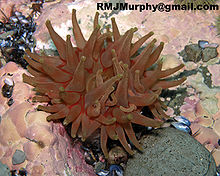- Northern red anemone
-
Northern Red Anemone 
Scientific classification Kingdom: Animalia Phylum: Cnidaria Class: Anthozoa Order: Actiniaria Family: Actiniidae Genus: Urticina Species: U. felina Binomial name Urticina felina
(Linnaeus, 1761) [1]The northern red anemone or dahlia anemone, Urticina felina, is a marine invertebrate found in the north Atlantic Ocean, the North Sea and the Baltic Sea. Synonyms include Tealia crassicornis (Müller, 1776), Tealia felina (Linnaeus, 1761), and Urticina crassicornis (Müller, 1776). The colour is variable. The sea anemone lives attached to rock on the seabed from the lower tidal limit down to a depth of 100 m and also attached to other organisms. It eats small fish and crustaceans, immobilizing its prey by firing groups of stinging cells (cnidae) into them.
Contents
Description
The base is up to 120mm across and firmly adherent to the rock. Deep sea specimens are usually larger than inshore ones. The column is usually shorter than its diameter and its surface is covered in verrucae. There is a parapet at the top where the verrucae tend to be organised into rows. The verrucae usually have bits of gravel and debris attached to them and the contracted anemone has the appearance of a rounded hummock of gravel. The disc is not broader than the parapet and has up to 160 short tentacles arranged in multiples of ten. The colour is very variable; some individuals have a red column with green blotches, grey verrucae and greyish banded tentacles; others have a red column and disc with grey verrucae and white tentacles. The tentacles are often banded and in many individuals there are thin red lines on the disc visible between the tentacles.[2]
Distribution
U felina is found in the Arctic Ocean, the Baltic Sea, the North Sea and the northern Atlantic Ocean as far south as the Bay of Biscay and the Gulf of Maine.[1]
Habitat
U felina is found on rocks and boulders from the lower shore down to depths of 100 metres. It occurs in rock pools, in crevices and gullies, among the holdfasts of Laminaria spp., in caves and partly buried in gravel.[2]
References
- ^ a b Urticina felina (Linnaeus, 1761) World Register of Marine Species. Retrieved 2011-09-01.
- ^ a b Urticina felina Marine Species Identification Portal. Retrieved 2011-09-01.
- Wildlife Fact File, 1996, Card #15
Categories:- Actiniidae
- Animals described in 1761
Wikimedia Foundation. 2010.
